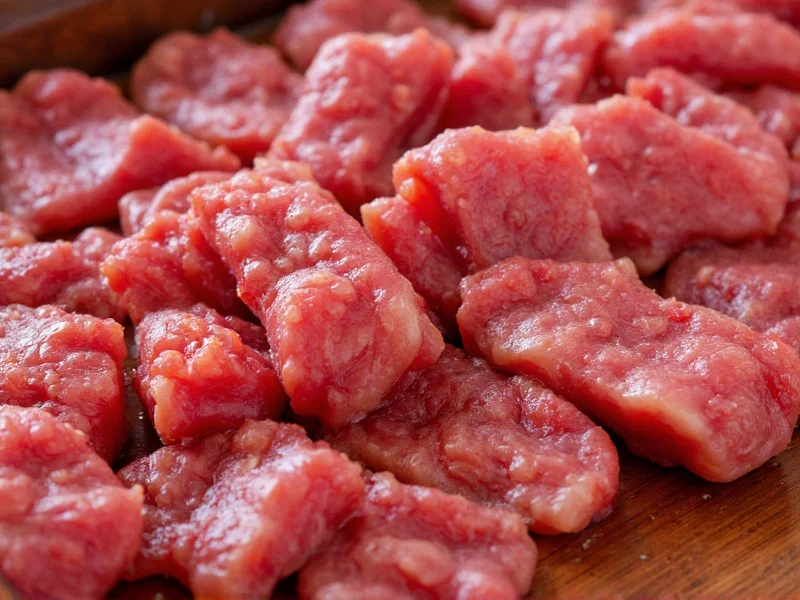Riblets represent a specific pork cut that often causes confusion among home cooks and barbecue enthusiasts. Understanding their precise anatomical origin helps clarify why they differ from other popular rib cuts. These tender morsels come from the dorsal area of the pig's rib cage, forming the transition section between the loin and the belly.
Anatomical Location of Riblets
When butchers process a hog carcass, they divide the rib section into three distinct portions. Riblets originate from the anterior portion of the rib cage, specifically ribs 1-5, which sit closest to the shoulder blade. This positioning gives riblets their unique characteristics compared to other rib cuts.
The confusion about where do riblets come from often stems from inconsistent labeling practices across different regions and butcher shops. Some retailers mistakenly label small spare ribs as riblets, while others use the term for trimmed baby back ribs. True riblets, however, come from that specific upper rib section near the spine.
| Rib Cut | Anatomical Location | Bone Size | Meat Characteristics |
|---|---|---|---|
| Riblets | Upper rib cage (ribs 1-5), near spine | Smallest bones | Highest meat-to-bone ratio, most tender |
| Baby Back Ribs | Along the spine, below loin | Curved, medium size | Leaner, more tender than spare ribs |
| Spare Ribs | Lower rib cage, belly side | Larger, flatter bones | More fat, richer flavor, meatier |
How Butchers Prepare Riblets
The process of creating riblets begins after the hog has been split and the loin has been removed. Butchers separate the rib cage into sections, with riblets requiring precise cutting to isolate that upper portion. Some processors further trim riblets by removing excess fat and connective tissue, creating what many restaurants serve as "dinosaur ribs" due to their distinctive shape.
Commercial producers sometimes create "riblet-style" products by cutting larger spare ribs into smaller portions, which contributes to consumer confusion about where do pork riblets come from. Authentic riblets maintain their characteristic curved shape and smaller bone structure that distinguishes them from other cuts.
Culinary History of Riblets
Riblets have gained popularity in American barbecue culture over the past few decades, though they've been part of traditional butchery practices for much longer. Their rise in restaurant menus coincided with the growing demand for convenient, portion-controlled meat options. The meat industry recognized that riblets offered an appealing combination of tenderness and visual appeal that resonated with diners.
Unlike baby back ribs, which come from higher up along the spine, or spare ribs from the belly side, riblets provide a unique eating experience. Their smaller size makes them ideal for appetizers or children's portions, while their location on the animal gives them a distinctive flavor profile that combines the best qualities of both loin and belly meats.
Common Misconceptions About Riblets
Several myths persist about what part of the pig are riblets. Some believe riblets come from calves or other animals, but authentic riblets exclusively come from pigs. Others confuse them with "plate ribs" or "short ribs," which originate from completely different sections of the animal.
The question of where do riblets come from often leads to confusion because some grocery stores label trimmed spare ribs as riblets. True riblets maintain their characteristic small, curved bones and come specifically from that upper rib section near the spine. When shopping for authentic riblets, look for the distinctive curved shape and smaller bone structure that indicates their proper anatomical origin.
Cooking with Authentic Riblets
Understanding riblets cut of meat origin helps cooks prepare them properly. Their higher meat-to-bone ratio means they cook faster than traditional ribs and require careful attention to prevent drying out. Many pitmasters prefer indirect smoking methods at lower temperatures (225-250°F) for 3-4 hours to achieve optimal tenderness without losing moisture.
Their anatomical position gives riblets a slightly different fat distribution than other rib cuts, with marbling that melts beautifully during slow cooking. This makes them particularly suitable for dry rubs that penetrate the meat effectively. When prepared correctly, riblets offer a delicate balance of meatiness and tenderness that distinguishes them from other pork rib varieties.
Are riblets from pigs or another animal?
Riblets exclusively come from pigs. They represent a specific cut from the upper portion of a pig's rib cage, near the spine. While other animals have rib sections, the term "riblets" specifically refers to this pork cut.
How do riblets differ from baby back ribs?
Riblets come from the uppermost portion of the rib cage (ribs 1-5), closer to the shoulder, while baby back ribs come from along the spine below the loin. Riblets have smaller, more curved bones and a higher meat-to-bone ratio than baby back ribs, which are straighter and meatier overall.
Why are riblets sometimes called dinosaur ribs?
Restaurants often call riblets "dinosaur ribs" because of their distinctive curved shape and small bone structure that resembles what people imagine dinosaur bones might look like. This marketing term helps distinguish them from regular ribs on menus and creates visual appeal for customers.
Do riblets contain more meat than regular ribs?
Yes, authentic riblets have a higher meat-to-bone ratio than traditional spare ribs, though slightly less meat than baby back ribs. Their smaller bones mean more edible meat per bone compared to other rib cuts, making them popular for portion-controlled servings.
Can you find riblets at most grocery stores?
Finding authentic riblets can be challenging at standard grocery stores, as many retailers mislabel trimmed spare ribs as riblets. Your best chance is at specialty butcher shops or higher-end grocery stores with dedicated meat counters. When shopping, look for the distinctive small, curved bones that indicate true riblets rather than just small portions of spare ribs.











 浙公网安备
33010002000092号
浙公网安备
33010002000092号 浙B2-20120091-4
浙B2-20120091-4